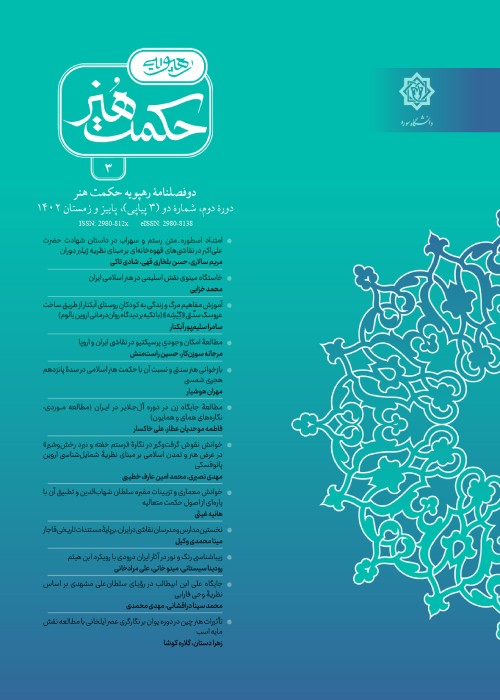Dressing: The Traditional Art of Ethics in Chitsazan's Fotovvatnameh
Many narrations indicate that morality and spirituality are current in the fields of Muslim life. Dressmaking is a traditional art-craft that is aligned with ethical principles. Clothing has two dimensions, appearance, and content: The change of its appearance dimension can be seen during time and space, and the content dimension of clothing is part of its unchanging identity, which in religious worldview is an expression of the essence and principle of truth. Attributing this matter to imams and performing the steps of this art by mentioning the verses of the Quran and resorting to remembrance, all express a transcendental view of it. The aim of this research is to understand the ethical elements of traditional dressing. Question: What are the most important ethical principles in creating the content of traditional Aryan clothing? Conclusion The covering system is a truth beyond the realm of matter. Referring to mystical sources can justify historical reflections on the meaning of traditional arts and the type of applied concepts in their structure based on transcendental matters. Dressmaking as an opportunity, in addition to professional skills, has moral elements that make this art-craft spiritual. Its most important moral elements are monotheism, based on the master-disciple system (qualification), and goodness of character. In this article, the content reading of ethical aspects of traditional clothing is done from the perspective of traditionalist philosophers (Cumaraswamy, Schoan, Burkhardt, and Nasr) and based on the text of Chitsazzan's Fotovvatnameh (as a historical-ethical guild text). The research method, the analysis of historical content, and the method of gathering information based on written documents are valid. Dressing as a traditional art in the opinions of Muslim traditionalist thinkers has dimensions of monotheism, functionalism, and usefulness. The spiritual charter of industries and arts in Islamic civilization, in the form of Fatu-Tanamehs, as a moral text, is aligned with these thoughts. In the investigation, it was found that clothes have form and meaning. From the point of view of traditional arts, its meaning has a transcendental and non-material aspect and is aimed at bringing the audience to the principle of tariqat. In the religious worldview, the form of every work of art is an expression of its essence, and the individuality of the artist has no role in the work, and art is an expression of the origin and principle of truth, and what is in the highest order is represented in a material form. Spiritual beliefs about cloth and clothing among traditionalists and their connection with the higher and spiritual levels of Shiite thought are evident in Chitsazan's Fatutnameh. This issue exists in the view of traditionalists towards traditional clothing, that what comes from the patterning on the garment and the type of construction is all in line with reaching a lofty goal.
- حق عضویت دریافتی صرف حمایت از نشریات عضو و نگهداری، تکمیل و توسعه مگیران میشود.
- پرداخت حق اشتراک و دانلود مقالات اجازه بازنشر آن در سایر رسانههای چاپی و دیجیتال را به کاربر نمیدهد.



